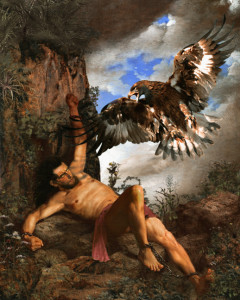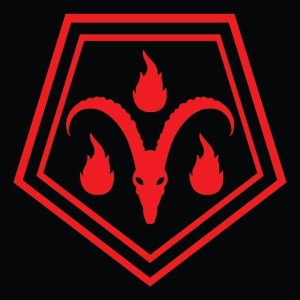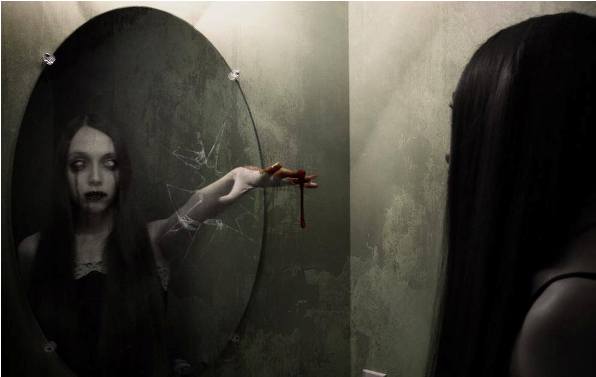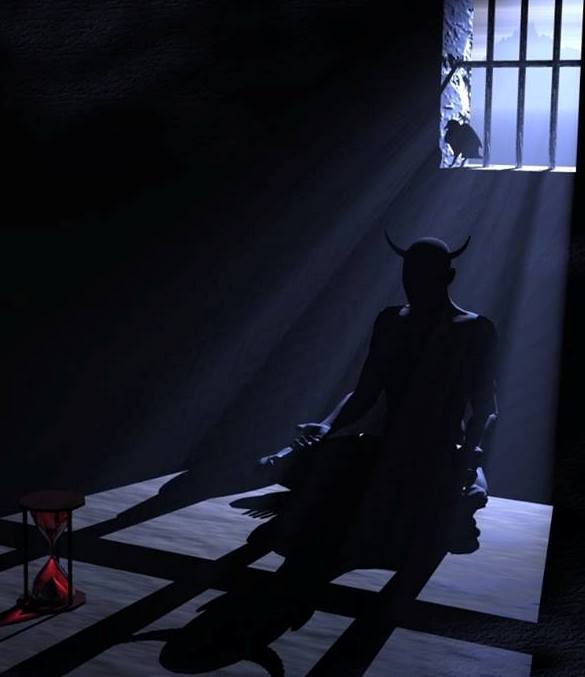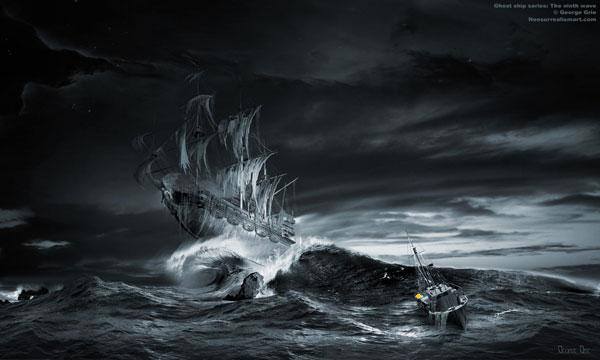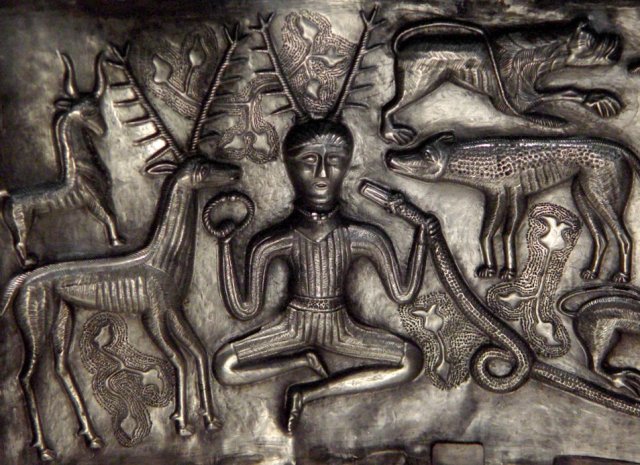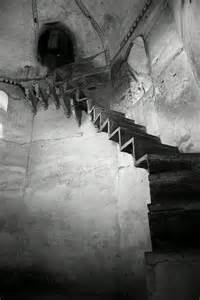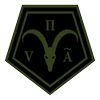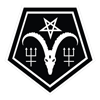Prometheus

by Thomas LeRoy, Founder of The Sect of the Horned God
“One thing that comes out in myths is that at the bottom of the abyss comes the voice of salvation. The black moment is the moment when the real message of transformation is going to come. At the darkest moment comes the light.”
— Joseph Campbell
What connection does Prometheus have to the left-hand path? In Greek mythology, Prometheus (whose name means “the one with foreknowledge”) had a reputation of being something of a trickster, one with a strong rebellious nature. His role was to stir up the existing order and not to bolster the power of Zeus, but to question it. In his book, “Lords of the Left-Hand Path” by Stephen Flowers, he states, “In the history of the kind of thought we are calling left-hand path in the West, it is difficult to overestimate the importance of the myth of Prometheus.”
To get an idea of the nature of Prometheus, we need to go back to the Greek myths themselves. The Titan Prometheus was one of the ringleaders in the battle between the Titans and the Olympian gods, led by Zeus. The goal was to gain control of the heavens. Prometheus switched sides, though, and supported the victorious Olympians when the Titans would not follow his advice to use trickery in the battle.
Eventually Prometheus was given the task by Zeus to create Man. He shaped Man out of mud, and Athena breathed life into his clay figure. Prometheus had assigned his brother Epimetheus (whose name means “afterthought”) the task of giving the creatures of the earth their various qualities, such as swiftness, cunning, strength, fur, and wings. Unfortunately, by the time he got to Man Epimetheus had given all the good qualities out and there were none left. So Prometheus decided to make Man stand upright as the gods did and, feeling sorry for Man’s weak and naked state, Prometheus raided the workshop of Hephaistos and Athena on Mt. Olympus and stole fire.
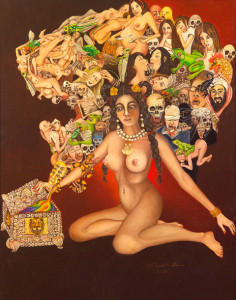
Partially with revenge in mind, Zeus sent Epimetheus a gift of the first woman, Pandora, who like Eve was blamed for causing all the evils humanity has had to suffer. Along with the curious woman, Zeus sent a closed box, telling Epimetheus it was not to be opened. Naturally Epimetheus gave the box to Pandora and, out of curiosity, she opened it. Out flew all the evils and plagues of the world: sorrow, disease, pestilence, war, etc. The only thing that remained in the box was hope.
Zeus, still angry with Prometheus for the theft of fire, sent his servants, Force and Violence, to seize the Titan and take him to the Caucasus Mountains where he would be chained to a rock with unbreakable adamanite chains. Here he was tormented by a giant eagle tearing at his liver. To add to the torment, the liver re-grew every night and the eagle returned each day to perpetually torture Prometheus.
But Zeus gave Prometheus a chance out of this predicament if he met two conditions. The first was that an immortal must volunteer to die for Prometheus, and the second was that a mortal must kill the eagle and unchain him. Eventually, Chiron the Centaur agreed to die for him and Heracles killed the eagle and unbound him.
Because of certain rebellious qualities, Prometheus has similarities to the Christian interpertation of Satan. In the book, “Lucifer and Prometheus” by R.J. Zwi Werblowsky, it is argued that the Satan of John Milton’s Paradise Lost is a strangely appealing character because of the attributes he shares with Prometheus. The book also points out the essential ambiguity of Prometheus and his dual Christ-like/Satanic nature as developed in the Christian tradition. Werblowsky also uses the terminology of Carl Jung in examining “mythological projections of the human psyche”, though he emphasizes that he is not interested in the concept of the archetype in the strict Jungian sense. Rather, he sees the myth of figures such as Satan and Prometheus as expressing “the shortcomings … of the world as conceived by the human soul.”
The myth of Prometheus is not simply a tale explaining how humans received the essential tool called fire, it instead metaphorically relates how we came upon that divine gift, that quality of the gods called intellect. The left-hand path is the individual’s quest to achieve divine power, or self-deification. And needed to journey this path is our own personal light. Without that gift from Prometheus we would be nothing more than beasts, naked on a path of ignorance, searching, crawling blindly toward any distant light.
Finding the Self on the Left-Hand Path
By Thomas LeRoy, Founder of The Sect of the Horned God
What is the self? You feel as though you are a thing with an intellectual sense, physical, but with an awareness. But try to capture that self. Go ahead. Sit in the dark, close your eyes and try to capture that essence that is you. You can’t. You are the whole of your parts, but not your parts. You are a process, fluid, changing, always in flux; an ever-shifting bundle of thoughts, feelings and memories.
We tend to think the self is as an integrated individual inhabiting a body. But according to neuroscientists, there is no single place in the brain that generates a self. On the flip-side, though, if we are a body inhabited by an undying soul — ghost in the machine — would we be the sum of those past lives? The answer is no. We would not be identical to that man that battled with the Irish forces against the Vikings at the Battle of Clontarf in 1014. Nor would we be that stable boy who had relations with the lady of the manor in 18th century England. We would be very different from those individuals. We would still have our independent identity.
While searching for the self, one cannot simultaneously be the hunter and the hunted. It would be like trying to grasp that image in the mirror with your hands; or having the image try to grasp you. It is you. So since we can’t capture the self, can we then guide it? The answer is yes, but what do we Satanists do with the self so that it progresses in a fashion that is beneficial?
The first question to ask is — are you on the left-hand path? You may call yourself a Satanist, but that does not mean you’re on the path. A Satanist is who you are. It is your identity. Just as some people are introverts and others extroverts, you may have certain traits that fall in line with that label called Satanist. The left-hand path, though, is something you have to choose to take. So, I’ll ask again — are you on it, or are you one stuck in a circle of conformity? A leaf in a stream, going with the flow?
The idea of the LHP is to create your own hero’s journey, to go counter-clockwise while reveling in your personal emancipation. It is taking that which you know as the self and carving your own path. Since you are ever-changing, always in flux, you have the choice to counter that natural flow and defy what may seem to be a scripted order. That scripted order is an illusion. It is you lying to the self. And there is no director guiding that script. If you follow it, though, you will find you have put up walls around the self, restricted it, preventing you from reaching that goal of self-deification. Outside influences may try to re-enforce those walls. It may be your parents, your community, society in general. Vanquish that illusion and instead follow the heterodox path, the LHP, toward the exaltation of the self.
Satanism and the Egocentric Predicament
by Thomas LeRoy, Founder of the Sect of the Horned God
“Everything is consciousness.”
Above is an example of one of those trippy-dippy-hippie bullshit New Age sayings that has been voiced by more than a few gluten-free, organic granola-eating types with a meaning lost to them, but since it was muttered by Deepak Chopra it must be deep. In truth, it has the depth of a drought-ridden California mud-puddle.
But what would happen if we rearranged those words? What if we wrote: “Consciousness is everything”? Does that have meaning?
The fact is, there is no truer statement. Consciousness is everything. All we know, all we see, feel, smell, etc. we do so with our minds. Our hands feel nothing, our eyes see nothing, our nose smells nothing, our ears hear nothing; it is all in the mind. And what is the mind? It’s that occupant of the brain. It is one with our consciousness.
But what is this thing called consciousness? Not an easy concept to define, but it has been described as the state of being awake and aware of what is happening around us, and of having a sense of “self”. We can never go so far as in creating a science of consciousness, for science is purely objective and consciousness is subjective. But it is said that consciousness can be quantified to a degree. It is believed that in the brain there are three different levels of consciousness. Level one is found in the back of the brain, also known as the reptilian, where we find the awareness of the space around us. Level two is found in the center. This is the mammalian brain, where awareness pertaining to relationships with others is found. Last, and located in the frontal lobe, is level three, the human, the part that allows us awareness of time, the future, tomorrow. But what about awareness of reality? Can we fully comprehend that? Maybe one day our brains will develop a fourth level of consciousness in a frontal-frontal lobe, but until that day the answer is no. We can not be sure if anything is real. It’s all perception. BUT, there is one thing we can be absolutely sure of — our own personal existence.
“Cogito ergo sum. I think, therefore I am.” The 17th century French philosopher René Descartes uttered those words with the idea that the mere act of thinking about one’s existence proves there is someone doing the thinking. We can know we exist, but we can never be sure as to the true extent, or location, of that existence. For all I know I am right now sitting in a rubber-padded room, straight-jacket on, in a puddle of my own piss imagining I founded a Satanic organization and that I live with a beautiful wife on a lovely winery in Northern California. Or I could be a head in a jar with electrodes hooked up to my brain feeding me a simulated reality like out of “The Matrix”. Or I’m simply pure consciousness trapped in a material reality created by the “Demiurge”. Who knows? The truth is we can not know for certain. But don’t get me wrong. If the objective reality is a simulation, or an illusion, one can’t help but notice that there are some pretty strict laws in this illusion that seem unbreakable. It wouldn’t be wise for one to jump off the roof of a skyscraper and attempt to manifest a staircase out of pure consciousness. Could end poorly.
So where does this lead us? Well, if we wholeheartedly and unabashedly want to seek the truth we have only one direction to go. Most look outward for answers; we go searching in an uncertain reality seeking 100% assurance when we should be looking inward!
Before the advent of psychology, one of the best tools to aid in our psychonautical studies was mythology. But most today ignore this tool, or attempt to make the gods and monsters of mythology “real” by using a little trick called faith. Some may get a true sense of fulfillment from faith, but they have missed the point. If myth is the song of the psyche that gives voice and substance to the archetypes of the collective unconscious, then faith is unnecessary. Once the journalist Bill Moyers said to mythologist Joseph Campbell, “You’re a man of faith.” Campbell’s response was, “No, I’m not. I don’t need faith when I have experience.” If you use the word “Satanists” in defining who you are, you too are delving into that experience of the mythological. You have found that psychological tool. You grasp it in your greedy little hand, for Satan is more than a word, but less than an absolute. Myth should be experienced, not believed. It is a way for us to better understand that which we know without a doubt is real — our consciousness.
The Collective Unconscious and the Left-Hand Path
By Thomas LeRoy, Founder of The Sect of the Horned God
The four pillars of the left-hand path educational foundation called The Sect of the Horned God are philosophy, psychology, mythology and the occult. These four sciences are represented by four men: Friedrich Nietzsche, Carl Gustav Jung, Joseph Campbell and Anton LaVey. And the most important of these disciplines (for it leads to a greater understanding of the other three) is the science of the mind — psychology. Jung, and his theory of the collective unconscious, has been an indispensable tool in our understanding of not only mythological archetypes, but also the occult.
During an individual’s lifetime the make up of the personal unconscious is manifested, but the contents of the collective unconscious invariably consist of archetypes that were present from the beginning. Archetypes are at the foundation of the collective unconscious. They represent basic human behaviors and situations. Thus, the mother-child relationship is governed by “The Mother” archetype, the truth-seeker in “The Sage”, the desire for power and control is represented in “The Ruler” and so on. Also, and in reference to the occult, mystic experiences are also governed by archetypes, not by entities from without. But the archetypes that are clearly characterized from an empirical point of view are those which have the most frequent and disturbing influence on the conscious self, or the “ego”. And the most accessible of these, and the easiest to experience, is the “Shadow”, for its very nature comes from, in greater part, the personal unconscious.
For a better understanding of the collective unconscious and the archetypes therein, picture a vast ocean, limitless, with small boats adrift upon that ocean. These boats represent our egos, or conscious selves. We are in control of our vessels to a certain extent, but in truth, we are at the mercy of the elements, namely the sea (the unconscious/collective unconscious). Swimming beneath its surface is an array of creatures that have an impact, large or small, upon our vessels. They could, with ease, swim from one to the other, either to the benefit, or degradation, of the individual ego. Those upon the left-hand path must endeavor to utilize these predators of the deep to the exaltation of the ego, rather than the degradation. They should, to a certain extent, be assimilated into the conscious personality to break away from the maelstrom that our boats (or egos) are at the misery of. But beware. If one attempts to draw these deeper creatures of the collective unconscious to the surface, they will invariably die, for they were never meant to be a part of objective reality. They are metaphor, symbols, whereby a literal interpretation will result in their demise; for a metaphorical truth is not an objective truth.
The shadow, though, that which is fed by the personal unconscious, can be brought to the surface through symbolic means. One way is by artistic representation, thus the ego is able to integrate rather than repress unpleasant unconscious impulses. Examples of positive shadow integration would be artists who deal with dramatic or foreboding themes, such as the paintings of the late H.R. Giger, or the writings of H.P. Lovecraft. But when repressed, the shadow may still find a way upon our boats, slithering on board and manifesting itself in unpleasant fashions.
We on the left-hand path have come to terms with our shadow. We do not shy away from the darker aspects of music, art, or philosophy. We are compelled by symbols such as Baphomet and the inverted pentagram, that most popular of LHP symbols. The inverted pentagram points downward to the depths of the vast ocean that is our shared unconscious, not toward the heavens. It invites us to look into the sea’s murky depths to seek out personal truths to aid us on our path.
The Source of Myths and Symbols
(While not a editorial or essay, this piece was published on the http://welshmythology.com/ website, and offers an excellent informative and historical view of myths and symbols. ~Babylon)
All myths and symbols arise initially in peoples imaginations, and if they are artists they will express them in creative terms more or less understandable to those around them. All of human imaginative life is inherently influenced by the unconscious, that aspect of the psyche that’s outside of our awareness, containing such things as instincts and automatic responses. Many psychologists believe the imagination acts as a medium between the conscious and unconscious mind, and as a result the art we create often gives us glimpses of our deeper, instinctive selves. Our creative urges move in response to these unseen currents of our own psychology.
As a theory* the unconscious was developed by the early psychologists of the 19th and 20th centuries, a group largely identified with Sigmund Freud and Carl Jung, although in truth there were many other theorists involved. Carl Jung went on to describe how the unconscious also contained a deep reservoir of accumulated ancestral forms that he called the collective unconscious. In describing the collective unconscious, Jung said:
. . . we might think of it as a collective human being combining the characteristics of both sexes, transcending youth and age, birth and death, and from having at its command a human experience of one or two million years, practically immortal. If such a being existed, it would be exalted above all temporal change; the present would mean neither more nor less to it than any year in the hundredth millennium before Christ; it would be a dreamer of age-old dreams and, owing to its immeasurable experience, an incomparable prognosticator. It would have lived countless times over again the life of the individual, the family, the tribe, and the nation, and it would possess a living sense of the rhythm of growth, flowering, and decay.
(Carl Jung, Collected Works vol. VIII, par. 673)
Through their research, Freud, Jung and many others came to perceive that the unconscious could be understood in mythological terms. One way in which the unconscious expresses itself is through primordial human figures and story-like narratives that gravitate around fundamental human experiences such as love, power, cunning, birth, death and self-knowledge. Jung called these deep, unconscious patterns archetypes, and identified some of them, such as the mother, the trickster and the wise old man. Just as Jung describes the collective unconscious in terms of the totality of human experience, archetypes can be described as those continually arising themes in that collective experience.
For scholars such as Carl Jung and Joseph Campbell, the cohesion of human global culture, the consistency with which the same archetypal patterns emerge in different regional cultures testifies to the existence of such a collective unconscious. For example, the tidal movements of the mass media, the memes and trends, fashions and fads can all be interpreted as following the pull of archetypal figures and narratives. To this day, just like countless ancestors before us, we are fascinated by heroes and villains, the trickery and intrigue of politics and power, the magic of science, religion and art, the otherness and familiarity of nature. These mythological figures and narratives can all be traced back to our shared, collective unconscious. In this way its one of the sources of culture and language, the basic stuff of meaning.
Mythic art.
Artists who have a particular sensitivity to the shared, collective unconscious will often create art that has a significant resonance within their own cultures. The fashion world exemplifies this process better than most aspects of modern culture, with designers reinterpreting old styles and garments within new contexts, finding what is most relevant to the most people. It could be argued that all art and culture has evolved along similar lines to biological evolution, with the most successful expressions of collective myth being the most enduring and at the same time the most adaptable. Those myths and symbols that manage to retain their influence as they change contexts will surely last longer than those that do not. As reflected in modern consumerism, there is great value in being able to create and express symbols endorsed by popular opinion for successive turns of the cultural wheel. This is exemplified by the modern practice of branding that strives to perpetuate the popularity of a single iconic image for an extended period of time. These modern symbols, although not explicitly set in a mythological context, inevitably draw on the universal mythic substratum of culture. Even though they have replaced older mythic symbols, they still exert a similar kind of power and influence.
The gods.
Its not difficult to find in the concept of an archetype a rational explanation for gods and their powers. Many scholars have explored the idea that myths, even those expressed in a medieval form such as the Four Branches, were originally tales about gods. But it must be born in mind that the modern conception of gods and supernatural agency, particularly in the atheistic cultures of the West, may very well be far removed from how these things were experienced by people in the past. The well established practice of rationalism in modern academia necessarily separates gods and divine powers out from the individual so as to reveal them as cultural fabrications; once they have been separated out as such they naturally dissolve to the touch, converted into nothing more than words and ideas. But to experience such things as core elements of one’s self, as people in the past surely did, means these gods could not be separated out from the individual in any meaningful way. We must therefore bare in mind that when we reduce ancient gods and their powers to rational concepts such as the collective unconscious and its archetypes, we don’t automatically discount the power of belief in the creation of culture, for that would skew our own understanding of the historic past regardless of our own position on such things.
What symbols say.
But what exactly is a symbol in this sense? Its impossible to know what the unconscious actually contains; we can’t open up the brain and peer into it as we would a loft in a house. But we can guess at its nature by paying attention to how it influences the conscious mind. By watching the ripples on the surface we can make guesses at how the currents deep bellow are moving. By studying the symbolic images that rise up into conscious awareness, Jung believed that we could interpret the movements of the unconscious. This led him to perceive that one of the basic qualities of the unconscious is its continual attempt to redress psychological balance. He said:
The unconscious, [is] the neutral region of the psyche where everything that is divided and antagonistic in consciousness flows together into groupings and configurations. These, when raised to the light of consciousness, reveal a nature that exhibits the constituents of one side as much as the other; they nevertheless belong to neither but occupy an independent middle position.
(Carl Jung, Psychological Types, p.113)
Jung saw the unconscious as the place where the psyche attempts to regulate the different influences that flow into it. It brings conflicting elements together into what he called groupings and configurations that in turn are expressed in the conscious mind as symbols: images that contain a blending of the original influences. If this theory is correct, then when such symbols are expressed consciously, we should be able to see in them traces of those initially conflicting influences, but presented in a more or less stable state. I’ll explore this idea in the next post.
———————————————–
*It must also be stressed that the theory of the unconscious is by no means uncontroversial: many current researchers tend to remodel the notion of non-conscious processes according to recent developments in neurological science. But this new context of understanding doesn’t change the fact that regardless of their biological correlations and influences, non-conscious phenomena can still be interpreted on both individual and communal levels in terms of mythology.
Hyperborean Transcendence — Evolving Beyond Personal Laws of Limitation
By Jake Block
The Unknown Known
by Anton Szandor LaVey (The Satanic Rituals pp. 219-220)
Despite others’ attempts to identify a certain number with Satan, it will be known than Nine is His number. Nine is the number of the Ego, for it always returns to itself. No matter what is done through the most complex multiplication of Nine by any other number, in the end the final equation nine will stand forth.
The true ages of times are cast in the likeness of Nine, with all cycles obedient to its Law. All matters of terrestrial concern may be evaluated by the infallible resolution of Nine and its offspring. Action and reaction relative to humanity’s tribal needs are contained within successive nine-year periods: the total of both (eighteen years) is called a Working. The beginning and end of each Working is call a Working Year, and each midway point between Working Years displays a zenith of intensity for the Working which has been brought about. Nine eighteen-year Workings equal an Era (162 years). Nine Eras equal an Age (1,458 years), which has been mistakenly called a millennium. Nine Ages equal an Epoch (13,122 years).
Each Age (1,458 years) alternates as Fire or Ice, each differing in the means by which the Control presents its dictum. During the Age of Ice, man is taught to refrain from his pride and retreat from himself; then he will be good. During an Age of Fire, man is taught to indulge himself and to tear himself open and look inside; then he will be good. During an Ice Age, God is above. During a Fire Age, God is beneath. Throughout each Age, big things occur each eighteen years, for the Control must maintain a cycle of action and reaction within the greater cycle of Fire and Ice.
Meaningful and portentous messages are cast forth each eighteen years, and are acted upon for the eighteen years which follow, at the end of which a new statement appears. The Ice Age from which we recently emerged began in the year 508 “A.D.” Just as the Zenith of passion for what each Working has inspired occurs halfway between the Working Years, so the greatest intensity of each Age’s message occurs at its midpoint. Thus in the year 1237 “A.D.” man’s fervor for what the last Ice Age represented had reached its summit. That Age ended in 1966, and the new Age of Fire was born.
The twentieth century has prepared us for the future and the coming of the Age of Fire was well heralded in the last Working Years of the Ice Age. The peoples of the Earth have been touched by the vehicles of 1894, 1912, 1930, and 1948, and communication has been well wrought. The new Satanic Age was born in 1966, and that is why His Church was built.
The infant is learning to walk, and by the first Working Year of his age – that is to say 1984 – he will have steadied his steps, and by the next – 2002 – he will have attained maturity, and his reign will be filled with wisdom, reason and delight.
REGE SATANAS!
AVE, SATANAS!
HAIL, SATAN!
LaVey was fond of saying “Today’s madness is tomorrow’s norm,” meaning that the pendulum of acceptance and rejection swings from acceptance to rejection of fashion, of taste, of value and of law.” Change is the only sure thing, based on human whims and popular prejudice. Think of this passage from the reading, above:
“Each Age (1,458 years) alternates as Fire or Ice, each differing in the means by which the Control presents its dictum. During the Age of Ice, man is taught to refrain from his pride and retreat from himself; then he will be good. During an Age of Fire, man is taught to indulge himself and to tear himself open and look inside; then he will be good. During an Ice Age, God is above. During a Fire Age, God is beneath. Throughout each Age, big things occur each eighteen years, for the Control must maintain a cycle of action and reaction within the greater cycle of Fire and Ice.”
The Control. What is “THE CONTROL?” Is it the societal norm, a consensus of what is right vs what is wrong; a mandated law or contract of limitation in which citizens agree to abide under threat of personal penalty; a holy dictum from an all seeing and all knowing god pronounced from a mountain on tablets of clay, or is it simply man’s personally accepted limitation upon himself?
The answer is in who you ask this question of, because it will change respectively, dependent upon their philosophical, religious, cultural… even socio/economic standing in whatever cultural or societal grouping they may fall within. Which is the true direction and ultimate north star by which man may guide himself through the murky waters of his earthly existence? We go to great lengths to choose who among us will give us this direction, spending millions in national and personal wealth to promote and elevate “the select” to be “the CONTROL,” yet upon doing so, we inevitably (and naturally) come to the conclusion that they are inept at doing their jobs… jobs that WE placed them in positions for, TO CONTROL. We find fault in THEM, but in reality, the failing is invariably with US, as we naively accept that we NEED control, for we are incapable of controlling ourselves. We lack that wisdom. We need supervision.
Left to function under their primitive, emotional and untrained raw selves, most men will simply exist. If you tell him, “eat cake,” and leave a whole, delicious three layer triple chocolate and sugar sprinkled masterpiece in front of him, he will EAT CAKE until it is gone, or until he can no longer stuff his face with another bite, leaving the rest. He has followed the dictum, and now moves on, without the discipline to know that perhaps simply having a piece of cake and saving the rest for later might be in his better interests. He has no responsibility for the cake, and has no idea of consequences. He is simply doing what he does. Eventually SOMEONE gets the idea and learns to conserve, and they pass that message on to others who learn, becoming THE CONTROL by default. This, then, becomes the model that we begin to follow, knowing it and (as we will almost always revert to our primitive natures) resist change to our world because we have no idea of other options available. Fire and Ice. Given personal options and personal responsibilities, attitudes and actions change. Given a law, they become stagnant and simply follow life in rote memory. Here we can fall back on physics and apply it to the human condition (inertia). “Objects in motion tend to stay in motion and objects at rest tend to stay at rest unless acted upon by an external force.”
The Hyperborean mind becomes its own “external force,” in that in analyzing a given situation logically and as dispassionately as possible, a third option might be achieved. So, instead of seeing the cake with an EAT/DON’T EAT control (binary thinking,) one injects a third option of logic. Eat SOME, SAVE FOR LATER. To those with a logical and self-protective mind, this will seem to be simply common sense, but for those coddled into submissive, controllable lassitude, dependent on external control, not so much.
The idea of transcendency fits within the Hyperborean construct. In transcending the traditional limitations of unstructured and undisciplined thought, one can focus more upon what matters. Personal responsibility in all things makes this possible. In the simplistic example of the undisciplined cake eater, simply looking at it as action vs consequence shows that in simply eating, one is satisfying one’s immediate need, but in planning and conserving, one cans satisfy the immediate and long term needs as well. This model can be used in all aspects of one’s life, replacing simple binary thinking with alternatives as needed. The Hyperborean mind doesn’t accept the supernatural “god” or “control” option, but transcends into the supranatural realm of personal deification, in which one decides for themselves logically and with personal responsibility for the actions they take.
OK… now let’s tie this in with the Fire and Ice concept from LaVey’s piece, THE UNKNOWN KNOWN. If we think of ourselves as “X” — the SPOT — and suspend a pendulum above us, holding stationary, this would indicate where we as individuals stand on any given topic. To the left is FULL ACCEPTANCE and to the right is FULL REJECTION of a situation at hand. For the example at hand, the topic could be drug legalization.
Realistically, no one is going to start out as dead neutral on any subject of personal import. I will place myself 3/4 of the way to the FULL REJECTION side of the issue. Someone else might be on the opposite side, 3/4 of the way to FULL ACCEPTANCE. That’s ok. We’re looking for differences. We’re beginning to come to grips with our personal vs societal or cultural conditionings. We are where we are because we have our minds made up, sometimes as a knee-jerk reaction to something we see as abhorrent, and sometimes simply because it is adversarial or contrary to be in opposition of any idea not our own. How then do we act as our own external force to swing the pendulum?
Now, if we see our goal as to make everyone see and think our way, we want that pendulum to swing in our direction, so we will proselytize, we will cajole, we will shame others into thinking that we OBVIOUSLY have the right idea, and that only an idiot would see things differently. We see that it’s better (at least for us) if we stay here, comfortably set in our ways and beliefs. Our opposition is thinking the same way, trying desperately to keep that pendulum moving in the OBVIOUSLY right position, so he’s proselytizing, cajoling and shaming others as well. The result, stalemate… NOBODY WINS. The traditional (red pill/blue pill) option is that one side or the other will bitch, complain, moan and become such a pain in the ass that eventually people will begin to just submit to get some peace. We never really resolve anything… we CAN’T, simply because in matters of personal sovereignty, while we might listen to others, we can only do what is right for ourselves. Stalemate… lip service… constant struggles.
What I’ll call the Hyperborean Solution is to simply refuse to play the game. By using logic and rejecting the emotionality of a question, one can focus on what is important in any issue of choice. In doing so, one brings the positives and the negatives that are presented into personal perspective and one can embrace the pros and cons simply as that, balance… but only as it applies to you. Let it go. It really doesn’t matter on a personal level if person A or B does or does not use drugs. What matters is if YOU do, and if one is truthful to themselves and intellectually honest with themselves, they can evaluate the benefit vs detriment upon their own lives. Truly you are the control. You have the ability and the sovereign right to choose, provided you also accept total responsibility for that choice.
“Do not complain about that to which you need not subject yourself.” — 11 Satanic Rules of the Earth
You could spend your entire life in the mundanity of “adversarialism for adversarialism’s sake,” or you could just realize that the only thing you can truly control is YOU. If you want to change the hearts and minds of people, you can’t do it by showing them where they are wrong, but by showing them by example where you are right. Doing what you believe to be in your own best interests and showing the positive results is a powerful motivator and trumps a thousand hackneyed excuses and arguments every time.
The Hyperborean solution seems counterintuitive, yet centers the pendulum back to zero. In transcending the compulsion to “be right,” and quantifying that rightness in the number of sovereign individuals that we an cajole into thinking our way, we take firm control of our lives while still providing that external force for others who see and understand that not becoming involved in the petty, self-serving bickering of humanity, but getting on with the business of actually living, we prosper. We may not see the cataclysmic change of revolution to every problem at hand, but radical changes change radically again and again. Permanent change through understanding takes longer to propagate, but is well worth the effort.
A little known ritual of the Church of Satan was called The Madness of Andelsprutz, in which the inmates of an insane asylum have taken over and now madness becomes norm. In this ritual, preferably done in a stark white room, the participants are provided with a two sided mirror, one side reflective and the other side black and a black broad-tipped magic marker. In total silence they circulate the room, the mirror’s reflective face pointed outward, with the black side facing themselves, marker in hand. With each participant they encountered, they would stare into the mirror and mark out what imperfections they saw reflected in the mirror. The message soon became obvious. Like the old Pogo comic strip said, “We have met the enemy and he is us.”
It’s so much easier when you stop looking for imperfections in others and concentrate on making the most of what you have yourself.
Into The Hyperborean
Blessed are the strong, for they shall possess the earth.
Cursed are the weak, for they shall inherit the yoke!
Blessed are the powerful, for they shall be reverenced among men.
Cursed are the feeble, for they shall be blotted out!
Blessed are the bold, for they shall be masters of the world.
Cursed are the righteously humble, for they shall be trodden under cloven hoofs!
Blessed are the victorious, for victory is the basis of right.
Cursed are the vanquished, for they shall be vassals forever!
Blessed are the iron-handed, for the unfit shall flee before them.
Cursed are the poor in spirit, for they shall be spat upon!
Blessed are the death-defiant, for their days shall be long in the land.
Cursed are the gazers toward a richer life beyond the grave, for they shall perish amidst plenty!
Blessed are the destroyers of false hope, for they are the true Messiahs.
Cursed are the god-adorers, for they shall be shorn sheep!
Blessed are the valiant, for they shall obtain great treasure.
Cursed are the believers in good and evil, for they are frightened by shadows!
Blessed are those that believe in what is best for them, for never shall their minds be terrorized.
Cursed are the “lambs of God”, for they shall be bled whiter than snow!
Blessed is the man who has a sprinkling of enemies, for they shall make him a hero.
Cursed is he who doeth good unto others who sneer upon him in return, for he shall be despised!
Blessed are the mighty-minded, for they shall ride the whirlwinds.
Cursed are they who teach lies for truth and truth for lies, for they are an abomination!
Thrice cursed are the weak whose insecurity makes them vile, for they shall serve and suffer!
The angel of self-deceit is camped in the souls of the “righteous”.
The eternal flame of power through joy dwelleth within the flesh of the Satanist!
Let us always strive to the goal of power through joy, armed with knowledge, skill and wisdom borne of will and a lust for life.
“I’d rather laugh with the sinners than cry with the saints; you know that only the good die young.”
Only The Good Die Young — Billy Joel
The Need to Believe
By Zach Black
I learned a long time ago it is not worth arguing with religious folk. You can’t hope to achieve much trying to enlighten mystical, superstitious, and weak minded people. Why use logic and reason to argue or debate someone who has a deep rooted psychological need to resist it? It is like arguing the shape of a cloud with a blind man. People have a NEED to BELIEVE. I can’t help but see their faith for what it is: a neurotic coping mechanism deeply anchored in the character and emotional structure of a delusional and crippled victim. An even sadder fact is these righteous, pious pursuers of heaven will probably never recover. Their entire lives, security, thought process, logic, reasoning, longing and general impression of the world around them is built on such fairy tales. These very people burrow into the trusting and delicate minds of children their own fears and delusions. If faith based mentality was replaced over night with a rational objective approach to reality, most of these individuals emotional and mental health would crumble in days.
Faith is rooted in fear, a fear of the unknown, the unpredictable, and most of all, the fear of living a life free of conflicting neurotic mechanisms. It is one in which believers are entirely dependent on as a permanent copping mechanism and is little more than a delicate house of cards which represses guilt, rage, fear, lust, etc.
If you doubt that it is the fear of losing “control” and letting go that fuels religious fever and devotion, consider this question: why would organized religion launch crusades to exterminate entire cultures, population and races? It is done through the claim they are doing God’s work by ridding the world of savages, heathens, beastly, coarse, perverse and deviant people. It was too much for the Holy to see free, unrestrained happy people, half naked and not ashamed of their own passions. These “primitive and Godless” people threatened to expose the fear and inherent irrational contradictions that their culture, religion and faith rest and depend on. It was seen necessary to rid the world of people who reminded them of what it is like to not live in a world based on fear, control, rigidity and repression. The righteous will not tolerate being reminded of what they gave up in the way of life, regarding love and happiness, to pursue their faith. Ironically, they gave up the one thing they claim they value above anything else. The only thing they hope to reunite in some mystical intangible way is everlasting bliss with their Lord via their very essence and soul. It was necessary to burn thousands of women alive simply because they reminded these miserable, impotent men that they themselves once felt alive in their groins. What could be more murderously provoking than to arouse the last bit of lust in some miserable, resigned, hateful shell of a man who longs for death?
The righteous and holy will always attempt to remove and exterminate others who think differently, who don’t reinforce their delusions, including those that are equally crippled holy men of a different cloth. After all, what if the other religion is right? There was no clause for that in the gospels. So if they are right, that would make you wrong, and a cloud of anxiety and horror surely awaits. Is there any other reason or explanation to make light of how intelligent, educated worldly and presumably logical well adjusted people could ignore scientifically proven facts that are in sharp contradictions to their faith? Many scientists themselves are still spending their entire lives trying to prove evolution is false and that carbon dating and the known age of the universe around us is grossly inaccurate. In the opposition of all evidence and reason they still will not let go of their delusions. They can’t. It is simply something they are incapable of doing as it would mean an end to the fiction they have grown dependent on to cope and function. It would also mean a dissolution of the very deep emotional layers of repression and rigidity they have spent a life time building.
Not to mention for the first time in their lives they are unsure of what lies beyond.
If a man of average intelligence reviews the idea of God with a rational objective approach he will come to one conclusion: God is possible, but highly unlikely, and with this, one more Agnostic is born. God is nothing but an imaginary friend for adults.
The universal need to believe should be looked at as a mass induced psychosis. It is a protective mechanism evolved by early man after the horror, uncertainty and isolation he must have felt when leaving the comfort of the jungle for the open fields towards the unknown.
Cor-relation and Causation
By Mistress Babylon Consort
I got my laugh for the day reading this one. Originally posted by the Skeptical Spectacles, this just had me shaking my head. Sadly there are those out there who would believe it. That it is a meme should make the intention and mockery obvious to most, but it doesn’t always. Thomas LeRoy made this same point in his video about Specious Reasoning when comparing the cor-relation between pillows and car crashes: 99% of people killed in car crashes slept on a pillow the night before. It must be true then, right?
While cor-relation does not imply causation, there are many causes that catch global attention like an out of control firestorm and with it, reason burns down also. To many insist on relying on pseudo-scientific information that use words like “thought to be”, “may be related to”, etc while ignoring unbiased scientific data and information from reputable journals. .
Whatever happened to being skeptical?
The Science of Biblical Plagues
By Mistress Babylon Consort
A friend of mine posted this on an internet site and it’s a quick and humorous read that, in an off-beat way, combines logic and rational thinking while still poking fun at the “Biblical Exodus”. Taken from the movie “The Reaping, it’s a quote from Katherine Winter portrayed by actress Hilary Swank.
In 1400 B.C., a group of nervous Egyptians saw the Nile turn red. But what they thought was blood was actually an algae bloom which killed the fish, which prior to that had been living off the eggs of frogs. Those uneaten eggs turned into record numbers of baby frogs who subsequently fled to the land and died. Their little rotting frog bodies attracted lice and flies. The lice carried the bluetongue virus, which killed 70% of Egypts livestock. The flies carried glanders, a bacterial infection which in humans causes boils.
Soon afterwards, the Nile River Valley was hit with a three-day sandstorm otherwise known as the plague of darkness. During the sandstorm, intense heat can combine with an approaching cold front to create not only hail, but also electrical storms which would have looked to the ancient Egyptians like fire from the sky. The subsequent wind would have blown the Ethiopian locust population off course and right into downtown Cairo. Hail is wet, locusts leave droppings spread both on grain, and you have got mycotoxins. Dinnertime in ancient Egypt meant the first-born child got the biggest portion which in this case meant he ate the most toxins, so he died.
